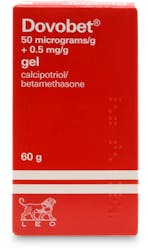Psoriasis treatment - Dovonex Ointment (PGD) 30g
Psoriasis treatment - Dovonex Ointment (PGD) 30g
What 500,000+ customers say about medino:
Get notified when back in stock
Description
Dovonex Ointment is a prescription medicine used to treat plaque psoriasis in adults. It contains calcipotriol, a vitamin D analogue that helps regulate skin cell growth. The ointment is recommended for use in adults and children from the age of 6.
Key Features
- Features calcipotriol, a vitamin D3 derivative
- Address plaque psoriasis in grown-ups
- Balances skin cell growth for symptom relief
- Established efficacy with good tolerance
- Applied directly to the affected area
- Being a prescription medication ensures expert oversight
How much time does Dovonex typically need to show results?
Most patients have observed the safety and effectiveness of Dovonex Ointment within an eight-week span. Yet, results can vary among individuals, making it crucial to heed healthcare providers' usage directions.
Is the facial application of Dovonex Ointment safe?
Applying Dovonex Ointment on the face is generally not advised due to potential skin irritation. Ensuring proper application and washing hands afterwards can prevent the unintended transfer to the face and eyes.
Can Dovonex Ointment be used for extended periods?
Over 400 patients underwent open-label clinical Dovonex Ointment trials for up to a year. Regardless, always adhere to healthcare providers' advice and usage recommendations.
Please note
This treatment is available only after a consultation with our pharmacist via a private service, called PGD (Patient Group Direction).
A picture of the affected area may facilitate and speed up the processing of your order. This can be sent to pharmacy@medino.com before or after you place the order.
It might be necessary to confirm the identity of the intended user through a verification process.
Please read the Patient information leaflet before starting the treatment.
Ingredients
Active Ingredient: 1 gram contains 50 micrograms of calcipotriol.
Excipient(s) with known effect: Propylene glycol
Read the patient leaflet for the full list of ingredients.
Usage and Instructions
Apply a thin layer to the affected skin twice a day. Leave it on the skin all day/night before bathing/showering. Wash your hands before/after use. Avoid sunlight exposure. Adults: Do not use more than 100 grams weekly. Children over 12 years: Do not use more than 75 grams weekly. Children aged 6 to 12 years: Do not use more than 50 grams weekly.
Warnings
Effects on Calcium Metabolism: Exceeding the maximum weekly dose of Dovonex may lead to hypercalcaemia due to its calcipotriol content, which is of concern, especially in certain psoriasis types. Serum calcium levels return to normal when treatment is stopped. Following dosage recommendations minimizes the risk. This product is contraindicated in patients with known disorders of calcium metabolism.
Local Adverse Reactions: Avoid applying Dovonex® to the face as it can cause skin irritation. Proper application and hand washing are crucial to prevent accidental transfer to the face and eyes.
UV Exposure: Patients on Dovonex Ointment should limit sun exposure. The use of Dovonex with UV radiation should only occur if potential benefits outweigh the risks, with physician guidance.
Unevaluated Use: Dovonex should be avoided in certain psoriasis types (guttate, erythrodermic, exfoliative, pustular) due to limited data. It should also be avoided in severe liver and kidney disease patients.
Adverse Reactions to Excipients: Dovonex®* ointment contains propylene glycol, which may cause skin irritation as an excipient.
Fire Hazard: Patients using Dovonex should not smoke or be near open flames, as the product makes fabric more flammable. Washing clothing and bedding may reduce but not entirely remove the product build-up.
Contraindicated in pregnancy and breastfeeding.
Side Effects
| Category | Frequency | Adverse Effects |
|---|---|---|
| Infections and Infestations | Uncommon (≥1/1,000 to <1/100) | Folliculitis |
| Immune System Disorders | Rare (≥1/10,000 to <1/1,000) | Hypersensitivity |
| Metabolism and Nutrition Disorders | Rare (≥1/10,000 to <1/1,000) | Hypercalcaemia |
| Skin and Subcutaneous Tissue Disorders | Common (≥1/100 to <1/10) | Psoriasis aggravated |
| Dermatitis | ||
| Erythema | ||
| Skin exfoliation | ||
| Skin burning sensation | ||
| Skin irritation | ||
| Pruritus | ||
| Uncommon (≥1/1,000 to <1/100) | Rash* | |
| Dry skin | ||
| Rare (≥1/10,000 to <1/1,000) | Photosensitivity reaction | |
| Skin oedema | ||
| Urticaria | ||
| Seborrhoeic dermatitis | ||
| Renal and Urinary Disorders | Rare (≥1/10,000 to <1/1,000) | Hypercalciuria |
| General Disorders and Administration Site Conditions | Common (≥1/100 to <1/10) | Application site pain |
| Uncommon (≥1/1,000 to <1/100) | Application site pigmentation changes |
*Various types of rash reactions such as exfoliative rash, rash papular, and rash pustular may occur.






